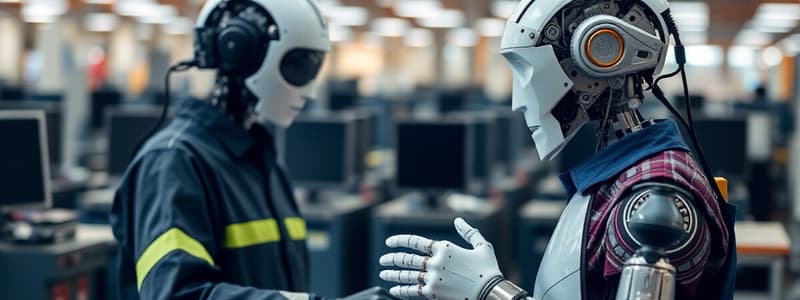Podcast
Questions and Answers
What is one potential negative outcome of excessive automation on social welfare?
What is one potential negative outcome of excessive automation on social welfare?
- Rise in productivity across all sectors
- Increase in overall employment rates
- Improvement in labor's share of income
- Reduction in the average wage (correct)
Which factor contributes to the decline in labor demand growth over the last three decades?
Which factor contributes to the decline in labor demand growth over the last three decades?
- Significant advancements in non-automated tasks
- High productivity growth coupled with low labor employment
- Increase in labor share in the economy
- Combination of low productivity growth and low reinstatement effect (correct)
How might the business strategies of leading firms influence the use of automation technology?
How might the business strategies of leading firms influence the use of automation technology?
- Encouraging innovation in non-automated sectors
- Favoring cost-cutting that leads to excessive automation (correct)
- Restricting the implementation of AI in production
- Promoting labor-intensive job creation
What hypothesis suggests that technology may always have a beneficial impact on labor?
What hypothesis suggests that technology may always have a beneficial impact on labor?
What aspect of taxation may disproportionately favor automation over labor?
What aspect of taxation may disproportionately favor automation over labor?
What describes the displacement effect of automation?
What describes the displacement effect of automation?
What is the primary role of the man in the factory of the future described by Warren Bennis?
What is the primary role of the man in the factory of the future described by Warren Bennis?
How has the labor share changed in the USA since the 2000s?
How has the labor share changed in the USA since the 2000s?
What is a potential economic consequence of the substitution effect in automation?
What is a potential economic consequence of the substitution effect in automation?
What does the reinstatement effect aim to achieve in response to automation?
What does the reinstatement effect aim to achieve in response to automation?
Wage polarization, in the context of automation, typically leads to:
Wage polarization, in the context of automation, typically leads to:
What is a significant ethical implication of increasing automation and AI in employment?
What is a significant ethical implication of increasing automation and AI in employment?
Which factor does NOT contribute to changes in the labor share according to the content discussed?
Which factor does NOT contribute to changes in the labor share according to the content discussed?
What is a likely effect of automation on employment as discussed in the content?
What is a likely effect of automation on employment as discussed in the content?
How does wage polarization affect the distribution of wealth?
How does wage polarization affect the distribution of wealth?
What ethical concern is highlighted by the use of low-paid workers in AI development?
What ethical concern is highlighted by the use of low-paid workers in AI development?
Which factor contributes to wage disparities as highlighted in the content?
Which factor contributes to wage disparities as highlighted in the content?
According to the content, what is one result of automation on job roles?
According to the content, what is one result of automation on job roles?
What economic impact is likely caused by wage polarization?
What economic impact is likely caused by wage polarization?
What does the statement by Adam Smith imply about labor and automation?
What does the statement by Adam Smith imply about labor and automation?
How does automation potentially impact job creation and destruction?
How does automation potentially impact job creation and destruction?
What is the primary assertion of the Dartmouth Proposal regarding machines and intelligence?
What is the primary assertion of the Dartmouth Proposal regarding machines and intelligence?
According to Asimov's laws, what is the highest priority that a robot must adhere to?
According to Asimov's laws, what is the highest priority that a robot must adhere to?
What concept emphasizes the relationship between technology and society in the development of AI?
What concept emphasizes the relationship between technology and society in the development of AI?
Which aspect of AI development is highlighted as essential to align with human values?
Which aspect of AI development is highlighted as essential to align with human values?
Which of the following best represents a common misunderstanding regarding technology's influence on society?
Which of the following best represents a common misunderstanding regarding technology's influence on society?
Which definition best captures the concept of artificial intelligence as described?
Which definition best captures the concept of artificial intelligence as described?
What aspect of autonomy in AI refers to systems that can independently define their values?
What aspect of autonomy in AI refers to systems that can independently define their values?
According to Geoffrey Hinton, what is the primary use of deep learning?
According to Geoffrey Hinton, what is the primary use of deep learning?
What characterizes autonomous predictive artificial systems?
What characterizes autonomous predictive artificial systems?
Which level of autonomy involves the ability to respond to different situations based on defined rules?
Which level of autonomy involves the ability to respond to different situations based on defined rules?
Which of the following statements about AI's relationship with prediction is correct?
Which of the following statements about AI's relationship with prediction is correct?
What does the term 'theory of mind' refer to in the context of autonomy in AI systems?
What does the term 'theory of mind' refer to in the context of autonomy in AI systems?
What is a main characteristic of a General Purpose Technology (GPT)?
What is a main characteristic of a General Purpose Technology (GPT)?
How does the substitution effect relate to the adoption of new technologies?
How does the substitution effect relate to the adoption of new technologies?
Which effect of GPTs increases the value of complementary resources?
Which effect of GPTs increases the value of complementary resources?
What historical impact can GPTs have according to the content discussed?
What historical impact can GPTs have according to the content discussed?
What is a significant outcome of the reduction in prediction costs due to AI as a GPT?
What is a significant outcome of the reduction in prediction costs due to AI as a GPT?
Which of the following is an example of a General Purpose Technology?
Which of the following is an example of a General Purpose Technology?
What role does the adoption of GPTs play in economic growth?
What role does the adoption of GPTs play in economic growth?
What does the concept of complementarity in relation to GPT imply?
What does the concept of complementarity in relation to GPT imply?
What is highlighted as a key issue in the adoption of new technologies and their impacts?
What is highlighted as a key issue in the adoption of new technologies and their impacts?
What does the polarization of wages imply within the context of automation?
What does the polarization of wages imply within the context of automation?
According to Adam Smith's perspective, what is a likely effect of improved machinery on labor?
According to Adam Smith's perspective, what is a likely effect of improved machinery on labor?
What is a potential consequence of automation on job creation and destruction?
What is a potential consequence of automation on job creation and destruction?
What two factors are suggested to contribute to increasing disparity in wages?
What two factors are suggested to contribute to increasing disparity in wages?
How do advancements in automation typically affect low-paid workers according to the content?
How do advancements in automation typically affect low-paid workers according to the content?
What is the significance of the median of annual gains in the context of job loss and gain?
What is the significance of the median of annual gains in the context of job loss and gain?
What common misconception about job growth and automation could lead to a misunderstanding of its effects?
What common misconception about job growth and automation could lead to a misunderstanding of its effects?
In the discussion of wages, how do socioeconomic factors intertwine with technology's impact on labor?
In the discussion of wages, how do socioeconomic factors intertwine with technology's impact on labor?
What could be a potential ethical concern surrounding the employment of low-paid workers in AI development?
What could be a potential ethical concern surrounding the employment of low-paid workers in AI development?
Flashcards
Productivity Effect of Automation
Productivity Effect of Automation
Automation technology increases productivity and creates demand for workers in non-automated tasks.
Deceleration of Labor Demand
Deceleration of Labor Demand
The slowing of job growth due to weak productivity gains and a limited impact of new jobs.
Automation's Impact on Labor Share
Automation's Impact on Labor Share
Automation can decrease the portion of overall earnings attributed to workers.
Excessive Automation
Excessive Automation
Signup and view all the flashcards
AI Automation's Potential Effects
AI Automation's Potential Effects
Signup and view all the flashcards
AI and Employment
AI and Employment
Signup and view all the flashcards
Dog and Man Parable
Dog and Man Parable
Signup and view all the flashcards
Labor Share
Labor Share
Signup and view all the flashcards
Substitution Effect
Substitution Effect
Signup and view all the flashcards
Composition Effect
Composition Effect
Signup and view all the flashcards
Displacement Effect
Displacement Effect
Signup and view all the flashcards
Reinstatement Effect
Reinstatement Effect
Signup and view all the flashcards
Income Inequality
Income Inequality
Signup and view all the flashcards
Job Loss vs. Gain (AI)
Job Loss vs. Gain (AI)
Signup and view all the flashcards
Polarization of Wages
Polarization of Wages
Signup and view all the flashcards
AI & Wages (Smith)
AI & Wages (Smith)
Signup and view all the flashcards
Education & Wage Gap
Education & Wage Gap
Signup and view all the flashcards
AI and Kenyan Workers
AI and Kenyan Workers
Signup and view all the flashcards
Impact of Automation
Impact of Automation
Signup and view all the flashcards
Analysis Source (AI)
Analysis Source (AI)
Signup and view all the flashcards
Reinstatement?
Reinstatement?
Signup and view all the flashcards
AI Definition (Dartmouth)
AI Definition (Dartmouth)
Signup and view all the flashcards
AI and Society Co-evolution
AI and Society Co-evolution
Signup and view all the flashcards
AI's Autonomous Nature (Philosophers)
AI's Autonomous Nature (Philosophers)
Signup and view all the flashcards
AI Ethics (High-Level Group)
AI Ethics (High-Level Group)
Signup and view all the flashcards
AI and Robotics (Asimov)
AI and Robotics (Asimov)
Signup and view all the flashcards
AI Definition (Oxford)
AI Definition (Oxford)
Signup and view all the flashcards
AI Definition (OECD)
AI Definition (OECD)
Signup and view all the flashcards
AI Economists' View
AI Economists' View
Signup and view all the flashcards
AI Autonomy (Level 1)
AI Autonomy (Level 1)
Signup and view all the flashcards
AI Autonomy (Level 2)
AI Autonomy (Level 2)
Signup and view all the flashcards
AI Autonomy (Level 3)
AI Autonomy (Level 3)
Signup and view all the flashcards
AI Autonomy (Level 4)
AI Autonomy (Level 4)
Signup and view all the flashcards
General Purpose Technology (GPT)
General Purpose Technology (GPT)
Signup and view all the flashcards
Cost Reduction (GPT)
Cost Reduction (GPT)
Signup and view all the flashcards
Complementarity Effect
Complementarity Effect
Signup and view all the flashcards
Substitution Effect (GPT)
Substitution Effect (GPT)
Signup and view all the flashcards
AI as GPT
AI as GPT
Signup and view all the flashcards
Prediction Costs Reduction
Prediction Costs Reduction
Signup and view all the flashcards
Adoption & Diffusion
Adoption & Diffusion
Signup and view all the flashcards
Productivity Gains
Productivity Gains
Signup and view all the flashcards
Examples of GPTs
Examples of GPTs
Signup and view all the flashcards
Job loss/gain (AI)
Job loss/gain (AI)
Signup and view all the flashcards
Wage Polarization
Wage Polarization
Signup and view all the flashcards
AI and Wages (Smith)
AI and Wages (Smith)
Signup and view all the flashcards
Education and Wage Gap
Education and Wage Gap
Signup and view all the flashcards
AI and Kenyan Workers
AI and Kenyan Workers
Signup and view all the flashcards
Impact of Automation
Impact of Automation
Signup and view all the flashcards
Reinstatement?
Reinstatement?
Signup and view all the flashcards
Study Notes
Understanding AI in Business Contexts
- AI is an autonomous force shaping society (Heidegger, 1962; Ellul, 1964; Habermas, 1968)
- AI development may be the end of the human race (Hawking)
- Technologies are shaped by human interests and values (Latour & Woolgar, 1979; Winner, 1980)
- AI development should align with values like responsible AI, humane AI, explainable AI, and meaningful human control. (High-Level Expert Group on AI, 2019; Floridi et al., 2020)
- Asimov's Three Laws of Robotics:
- A robot must not injure a human or allow a human to come to harm
- A robot must obey human orders unless conflicting with the First Law
- A robot must protect itself as long as it doesn't violate the first or second laws
- Technology and society co-evolve, creating unexpected consequences
- The study of AI should focus on how to make machines simulate human intelligence and improve themselves (Dartmouth Proposal, 1955)
- AI development, expert systems, neural networks, and deep learning are prominent trends in AI. (Minsky, 1967)
- AI advancements, such as AlexNet's victory in ImageNet's annual competition (Hinton, Srivastava, Krizhevsky, Sutskever and Salakhutdinov, 2012) or IBM's Watson defeating Jeopardy champions, highlight the development.
Artificial Intelligence (AI) Definitions
- AI is the study and development of computer systems designed to perform tasks typically requiring human intelligence. (Oxford English Dictionary)
- AI is a system that makes predictions, recommendations, or decision affecting real or virtual environments. (OECD, 2019)
- AI is the process of taking any problems with lots of data and improving solutions using existing techniques (Hinton, 2016).
- AI is increasing the power and reducing the cost of prediction. (Agrawal et al., 2018)
AI and Economic Growth
- AI's contribution to the global economy is predicted to reach $15.7 trillion by 2030 (PwC, 2017)
- Computing power used to train AI has doubled every six months. (Sevilla et al., 2022)
- Generative AI could impact 80% of the US workforce. (Eloundou et al., 2023)
- Software engineers can code twice as fast with AI tools. (Kalliamvakou, 2022; Noy and Zhang, 2023)
AI and the Productivity Paradox
- Productivity growth has slowed despite AI advancements.
Why AI matters (Secular Stagnation)
- The potential growth of digital technologies has potentially been exhausted (Gordon, 2012)
- The pace of new technology adoption and the effect on labor growth is slower than expected (Jovanovic and Rousseau, 1982)
General Purpose Technologies (GPTs)
- GPTs are technologies that have extensive uses and lead to a cumulative economic impact.
- Examples of GPTs: printing, bronze, the waterwheel, steam power, electricity, the internal combustion engine, railways, motor vehicles, lasers, the Internet, and AI (Lipsey et al., 1998)
AI and Employment
- Automation disrupts jobs, creating displacement and reinstatement effects causing worker displacement/reinstatement (Acemoglu and Johnson, 2022)
- Some sectors lose jobs (in retail, manufacturing, clerical) , but others emerge (in science).
- AI impact on employment often leads to increased inequality of income.
- There has been no widespread job destruction due to AI, yet despite increasing automation.
- Labor share has constantly decreased with AI automation in the US (Acemoglu et al., 2022)
- AI may lead to an increase in labor inequality.
AI and Wages
- The rise of AI may result in a polarization of wages, with the highest earners seeing the largest gains while many remain stagnant
- Productivity gains from AI could benefit some workers and hurt others leading to a widening wage gap.
AI and Ethics
- AI choices have important consequences that should be considered
- There is a need for regulation, and a balancing of competing values
- AI development should not be left to market forces alone; ethical considerations should guide its use and development
Ethical Guidelines for Trustworthy AI
- There are multiple facets of AI ethics to consider, including legal compliance, ethical principles and social/technical robustness
- Several guidelines exist to ensure AI's ethical use
- A human-in-the-loop model for AI may be essential to maintain ethical control
AI Act (EU)
- The EU wants humans to retain control over AI systems. Regulations such as GDPR, DSA, DMA, DGA, or data act may help.
- The Al Act (2025) is a potential move toward regulation in Europe.
Explainable AI
- Explainable AI (XAI) is crucial to understanding how AI algorithms work and reducing the number of factors
- The explainability of open-source/low-code AI needs more attention
Ethical Governance
- A distributed agency is needed to oversee ethical AI development among stakeholders, such as researchers, users or regulators
Studying That Suits You
Use AI to generate personalized quizzes and flashcards to suit your learning preferences.
Related Documents
Description
Test your knowledge on the impact of automation on social welfare and labor demand. This quiz covers various aspects, including business strategies, taxation, and hypotheses regarding technology's effects on the workforce. Challenge yourself to understand the complexities of automation in today's economy.




